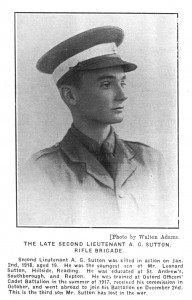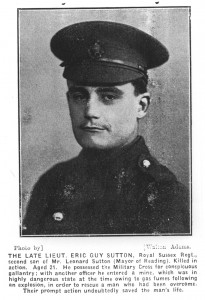Alexander Gordon Sutton
2nd Lieutenant
2nd Battalion Rifle Brigade
Division 65
 |
Alexander Gordon Sutton was killed in action on 2 January 1918 aged 19.
He is buried in Oxford Road Cemetery, Ypres. Grave location V. H. 9.
Alexander Gordon Sutton was the grandson of Martin Hope Sutton and the youngest son of Leonard Goodhart Sutton and Mary Charlotte Sutton (nee Seaton). His mother had died in July 1900 probably giving birth to Emily the only girl in the family. The family home was ‘Hillside’ Allcroft Road, Reading. The 1911 census indicates that Alexander, aged 12 and his brother Noel and sister Emily were at the family home. The house was run by a team of ten servants.
Like his brother Eustace, Alexander was educated at St. Andrews, Southborough and Repton Schools. He was in training at Oxford with the Officers’ Cadet Battalion and received his commission in October 1917. He joined his battalion on 2 December 1917.
His obituary stated that he was a well known member of St. John’s Church, Reading which he attended with the other members of his family whilst in Reading. He was described as having a thoughtful and reverent demeanor. (St. John’s Church is now used by the Polish Roman Catholic community)
He was the third son of Leonard Goodhart Sutton to be killed in action.

